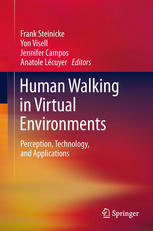

Most ebook files are in PDF format, so you can easily read them using various software such as Foxit Reader or directly on the Google Chrome browser.
Some ebook files are released by publishers in other formats such as .awz, .mobi, .epub, .fb2, etc. You may need to install specific software to read these formats on mobile/PC, such as Calibre.
Please read the tutorial at this link: https://ebookbell.com/faq
We offer FREE conversion to the popular formats you request; however, this may take some time. Therefore, right after payment, please email us, and we will try to provide the service as quickly as possible.
For some exceptional file formats or broken links (if any), please refrain from opening any disputes. Instead, email us first, and we will try to assist within a maximum of 6 hours.
EbookBell Team

4.1
60 reviewsThis book presents a survey of past and recent developments on human walking in virtual environments with an emphasis on human self-motion perception, the multisensory nature of experiences of walking, conceptual design approaches, current technologies, and applications. The use of Virtual Reality and movement simulation systems is becoming increasingly popular and more accessible to a wide variety of research fields and applications. While, in the past, simulation technologies have focused on developing realistic, interactive visual environments, it is becoming increasingly obvious that our everyday interactions are highly multisensory. Therefore, investigators are beginning to understand the critical importance of developing and validating locomotor interfaces that can allow for realistic, natural behaviours. The book aims to present an overview of what is currently understood about human perception and performance when moving in virtual environments and to situate it relative to the broader scientific and engineering literature on human locomotion and locomotion interfaces. The contents include scientific background and recent empirical findings related to biomechanics, self-motion perception, and physical interactions. The book also discusses conceptual approaches to multimodal sensing, display systems, and interaction for walking in real and virtual environments. Finally, it will present current and emerging applications in areas such as gait and posture rehabilitation, gaming, sports, and architectural design.